Paleontology Laboratory and Fossil Collections
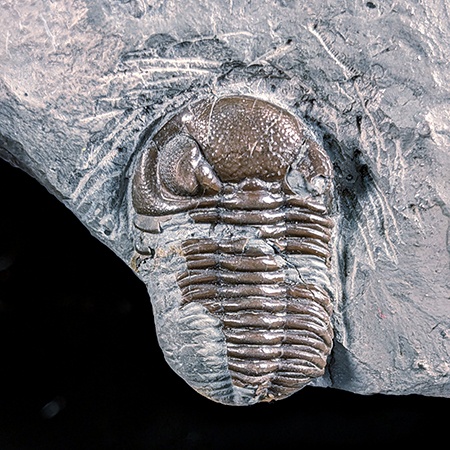
Welcome to BGSU’s Paleontology Laboratory and Fossil Collections! BGSU is one of the only universities in the United States to offer an undergraduate specialization in Paleobiology, completed within our Geology B.S. degree program. In support of this program, the School of Earth, Environment & Society maintains one of the largest collections of fossils in the state of Ohio.
Undergraduate and graduate students in paleontology pursue research on how organisms have responded to climate changes during Earth’s long history, using phylogenetics, morphometrics, and ecological techniques to link processes of evolution, ecology, and extinction in marine and terrestrial organisms.
Please explore the tabs below to learn more about our collections, research, teaching, and outreach activities.

Dr. Peg Yacobucci | Professor of Geology, Faculty Mentor for Paleobiology Specialization
Forrest Clark | MS Student
Thesis - Determining recent past salinity of Florida Bay and Biscayne Bay using modern benthic foraminifera: A weighted-average tool for conservation paleobiology
Bart Frazier | MS Student
Thesis - North American Tayassuidae Ecological Niche Modeling and Correlations with Early Humans
Ken Layton | MS Student
Thesis - Baculitid phylogenetic reconstruction from a Bayesian perspective
Gabriel Soto | BS Geology (Paleobiology) Student
Research - Quantifying trends in ammonoid suture complexity through the Cenomanian-Turonian interval
Ina Terry | Adjunct Instructor and Alumna
2013 MS thesis - The Ohio Pleistocene Mammal Database (OPMDB): Creation and Preliminary Taphonomic and Spatial Analyses, http://rave.ohiolink.edu/etdc/view?acc_num=bgsu1377456136
Allen Uycoque | MS Student
Thesis - TBD
Kaylee Walty | MS Student
Thesis - Deciphering Desmoceratoidea turnover rates during Cenomanian-Turonian Ocean Anoxic Event 2 using a Bayesian phylogenetic approach
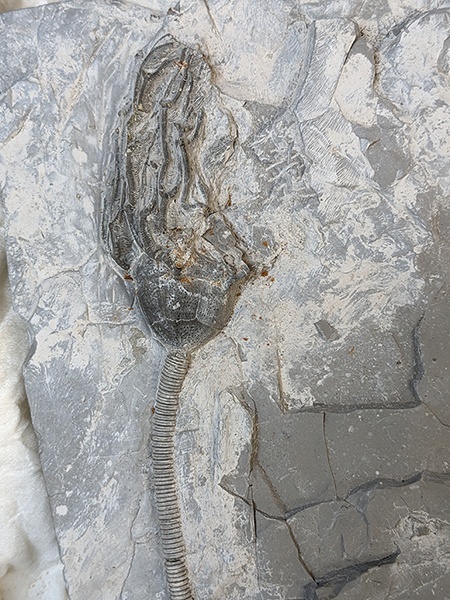
BGSU is home to one of the largest collections of fossils in the state of Ohio, including over 120,000 Paleozoic marine invertebrate fossils and smaller holdings of Mesozoic and Cenozoic marine and terrestrial specimens. We have particular strengths in marine life of the Devonian and Pennsylvanian periods, as well as a collection of Plio-Pleistocene marine macro- and microfossils from Florida.
Among our Ice Age collection are BGSU's flat-headed peccary, Platygonus compressus, and our mastodon, Mammut americanum, both from northwest Ohio.
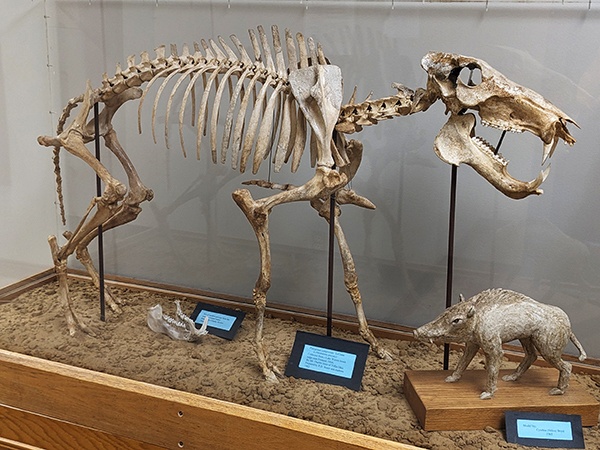
The paleontology lab includes mechanical and chemical fossil preparation equipment and a digital photography/photogrammetry set-up.
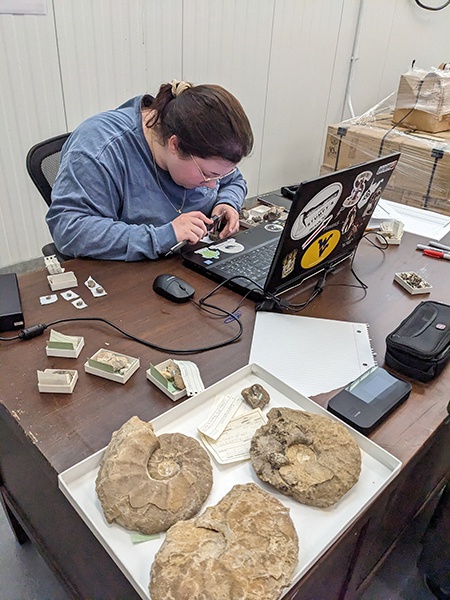
BGSU faculty and students pursue research on a wide range of paleontological topics. Two primary research areas are:
- Understanding how ancient life responded to environmental changes, which can inform efforts to mitigate the negative impacts of modern anthropogenic climate change
- Exploring causes of evolution and extinction: Why do some groups diversify and make lots of new species while others evolve slowly, if at all? Why do some groups suffer widespread extinction during Earth crises while other groups survive unscathed?
Our lab group has particular expertise in quantitative approaches to studying fossils, including morphometrics, phylogenetics, paleoecology, and paleobiogeography, and much of our work focuses on the Devonian, Cretaceous, and Pleistocene time intervals.
Current Externally Funded Projects
Collaborative research in partnership with University of Nebraska-Lincoln: Associations between climate shifts and ammonoid turnover across second-tier extinctions during the early Late Cretaceous greenhouse
National Science Foundation Award No. 2129629, April 2022-March 2025, $164,998
As climate changes, it will be important to accurately predict how environmental shifts will impact marine animals in order to assist conservation biology efforts. Cephalopods like squid and octopus are ecologically important, as both predator and prey, and economically important for the U.S. fisheries industry. This project will investigate patterns of evolution and extinction in fossil relatives of modern squid and octopus, the ammonoids. Between 90 and 100 million years ago, Earth experienced multiple episodes of cooling and warming. By investigating the traits that helped some ammonoid species survive these events, the project will identify key factors that control extinction risk in cephalopods. BGSU students Kaylee Walty (MS, Geology) and Gabriel Soto (BS, Geology) are working on this project.
Determining recent past salinity of Florida Bay and Biscayne Bay using modern benthic foraminifera: A weighted-average tool for conservation paleobiology
Supplemental National Science Foundation award to support M.S. student Forrest Clark’s summer internship partnering with U.S. Geological Survey scientists, May-August 2023, $31,058
Forrest’s thesis research involves a collaboration with U.S. Geological Survey geologist Dr. Lynn Wingard, who is leading a conservation paleobiology research project in Florida and Biscayne Bays, connected to the multi-agency Greater Everglades Ecosystem Restoration project. This internship funding will support Forrest as he travels to Florida Bay to conduct field work with USGS staff and to the USGS facility in Reston, Virginia, to conduct lab work and learn more about the sediment samples and cores he will be processing for benthic foraminifera, single-celled organisms that are sensitive indicators of water conditions. Forrest’s work will benefit the USGS, since they do not have anyone working on foraminifera as (paleo)environmental proxies. Forrest’s work will focus on developing a quantitative technique for translating information about what foraminiferan species are present in a modern or ancient sediment sample to the estimated salinity of the water at that place and time.
* indicates BGSU student author
Peterman, D.J., Hebdon, N., Ciampaglio, C.N., Yacobucci, M.M., Landman, N.H., and Linn, T. 2020. Syn vivo hydrostatic and hydrodynamic properties of scaphitid ammonoids from the U.S. Western Interior. GeoBios 60: 79-98. https://doi.org/10.1016/j.geobios.2020.04.004.
Peterman, D.J., Shell, R., Ciampaglio, C., and Yacobucci, M.M. 2020. Stable hooks: biomechanics of heteromorph ammonoids with U-shaped body chambers. Journal of Molluscan Studies 86: 267-279. https://doi.org/10.1093/mollus/eyaa018.
Peterman, D.J., Yacobucci, M.M., Larson, N.L., Ciampaglio, C., and Linn, T. 2020. A method to the madness: Ontogenetic changes in the hydrostatic properties of Didymoceras (Nostoceratidae, Ammonoidea). Paleobiology 46(2): 237-258. https://doi.org/10.1017/pab.2020.14.
Peterman, D., Barton, C.C., and Yacobucci, M.M. 2019. The hydrostatics of Paleozoic ectocochleate cephalopods (Nautiloidea and Endoceratoidea) with implications for modes of life and early colonization of the pelagic zone. Palaeontologia Electronica 22.2.24A: 1-29. https://doi.org/10.26879/884.
Peterman, D.J., Ciampaglio, C.N., Shell, R.C., and Yacobucci, M.M. 2019. Mode of life and hydrostatic stability of orthoconic ectocochleate cephalopods: Hydrodynamic analyses of restoring moments from 3D-printed, neutrally buoyant models (Editors’ choice). Acta Palaeontologica Polonica 64. https://doi.org/10.4202/app.00595.2019.
Yacobucci, M.M. 2018. Confronting prior conceptions in paleontology courses. Pedagogy and Technology in the Modern Paleontology Classroom. Paleontological Society Short Course Volume; Elements of Paleontology. https://doi.org/10.1017/9781108681391.
Yacobucci, M.M. 2018. Postmortem transport in fossil and modern shelled cephalopods. PeerJ 6: e5909. https://doi.org/10.7717/peerj.5909.
*Gaetano, T.M., Yacobucci, M.M., and Bingman, V.P. 2017. On the paleontology of animal cognition: Using the brain dimensions of modern birds to characterize maniraptor cognition. Journal of Advanced Neuroscience Research, Special Issue, May-2017: 12-19. https://doi.org/10.15379/2409-3564.2017.03.
*Lockshin, S., Yacobucci, M.M., Gorsevski, P., and Gregory, A. 2017. Spatial characterization of Cretaceous Western Interior Seaway paleoceanography using foraminifera, fuzzy sets, and Dempster-Shafer theory. GeoResJ 14: 98-120. https://doi.org/10.1016/j.grj.2017.10.001.
Yacobucci, M.M. 2017. Marine life in a greenhouse world: Cephalopod biodiversity and biogeography during the early Late Cretaceous. Paleobiology 43(4): 587-619. https://doi.org/10.1017/pab.2017.3.
Allmon, W.D., and Yacobucci, M.M. (eds.) 2016. Species and Speciation in the Fossil Record. Chicago, University of Chicago Press.
Yacobucci, M.M. 2016. Towards a model for speciation in ammonoids. Pp. 238-277 in: W.D. Allmon and M.M. Yacobucci (eds.). Species and Speciation in the Fossil Record. Chicago: University of Chicago Press.
De Baets, K., Bert, D., Hoffmann, R., Monnet, C., Yacobucci, M.M., and Klug, C. 2015. Ammonoid intraspecific variability. In: C. Klug, D. Korn, K. De Baets, I. Kruta, and R.H. Mapes (eds.). Ammonoid Paleobiology: From Anatomy to Ecology. Topics in Geobiology, Vol. 43. Dordrecht, Springer.
Monnet, C., De Baets, K., Yacobucci, M.M. 2015. Buckman’s rules of covariation. Pp. 67-94 in: C. Klug, D. Korn, K. De Baets, I. Kruta, and R.H. Mapes (eds.). Ammonoid Paleobiology: From Macroevolution to Paleogeography. Topics in Geobiology, Vol. 44. Dordrecht, Springer.
Yacobucci, M.M. 2015. Macroevolution and paleobiogeography of Jurassic-Cretaceous ammonoids. Pp. 189-228 in: Christian Klug, Dieter Korn, Kenneth De Baets, Isabelle Kruta, and Royal H. Mapes (eds.). Ammonoid Paleobiology: From Macroevolution to Paleogeography. Topics in Geobiology, Vol. 44. Dordrecht, Springer.
Bardin, J., Rouget, I., Yacobucci, M.M., and Cecca, F. 2014. Increasing the number of discrete character states for continuous characters generates well-resolved trees that do not reflect phylogeny. Integrative Zoology 9(4):531-541. https://doi.org/10.1111/1749-4877.12076.
*Knauss, M.J., and Yacobucci, M.M. 2014. Geographic information systems technology as a morphometric tool for quantifying morphological variability in an ammonoid clade. Palaeontologia Electronica 17.1.19A. http://doi.org/10.26879/418.
Landman, N.H., Goolaerts, S., Jagt, J.W.M., Jagt-Yazykova, E.A., Machalski, M., and Yacobucci, M.M. 2014. Ammonite extinction and nautilid survival at the end of the Cretaceous. Geology 42(8): 707-710. https://doi.org/10.1130/G35776.1.
Yacobucci, M.M. 2013. Integrating critical thinking about values into an introductory geology course. Journal of Geoscience Education 61(4): 351-363.
Yacobucci, M.M. 2012. Meta-analysis of character utility and phylogenetic information content in cladistic studies of ammonoids. Geobios 45(1): 139-143.
Yacobucci, M.M. 2012. Using active learning strategies to promote deep learning in the undergraduate paleontology classroom. Pp. 135-153 in: M.M. Yacobucci and R. Lockwood (eds.). Teaching Paleontology in the 21st Century. Paleontological Society Special Publications, Vol. 12.
Yacobucci, M.M., and Lockwood, R. (eds.) 2012. Teaching Paleontology in the 21st Century. Paleontological Society Special Publications, Vol. 12.
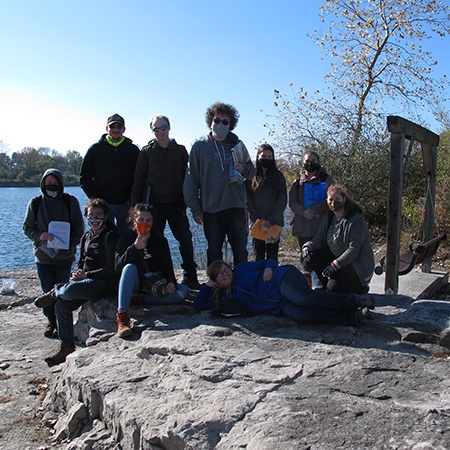
We offer a variety of courses in paleontology:
- GEOL 1050 Life Through Time (BG Perspective course)
- GEOL 2150 The Geologic History of Dinosaurs (BG Perspective course)
- GEOL 4150/5150 Paleontology (for upper-level undergraduates and MS students)
- GEOL 4190/5190 Vertebrate Paleontology (for upper-level undergraduates and MS students)
- GEOL 6310 Quantitative Paleontology (for MS students)
Undergraduate Paleobiology students also complete an independent research project in paleontology for course credit.
BGSU is one of the only universities in the United States to offer an undergraduate specialization in Paleobiology, completed within our Geology B.S. degree program. Paleobiology students gain a solid background in the anatomy, evolution, and paleobiology of major invertebrate and vertebrate fossil groups and their deep-time histories as well as experience with practical lab and research methods.
For more information about our undergraduate specialization in Paleobiology, visit our website.
Read about recent Paleobiology alumnus Carlos Martinez's experience at BGSU.
We also offer a minor in Paleontology that is open to all majors. Please see the Undergraduate Catalog for current course requirements for this minor.
Interested in pursuing paleontology research in graduate school? Check out our MS in Geology degree program.
Have questions about our courses and programs in paleontology? Contact Dr. Yacobucci.
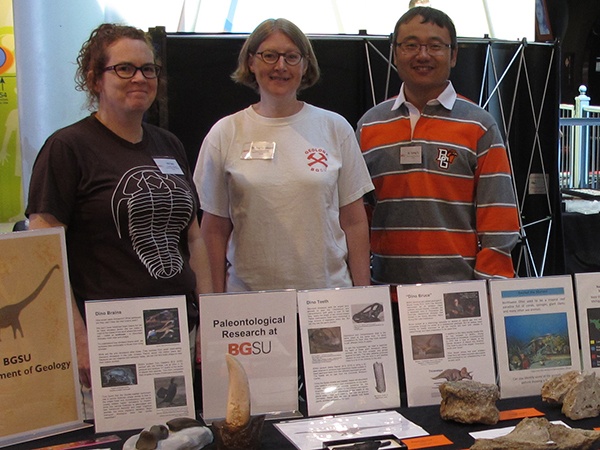
Hear Dr. Yacobucci talk about her career and advice for future paleontologists:
“Girl Power: Meet a STEM Professional” by Imagination Station Toledo https://www.youtube.com/watch?v=2Y16WHxv9y8
Dr. Yacobucci's profile for “Daring to Dig: Women in American Paleontology” virtual exhibit by the Museum of the Earth, Paleontological Research Institution, Ithaca, NY
Interested in inviting Dr. Yacobucci and the Paleo students to visit your classroom or give a talk to your group about paleontology and Earth’s fascinating history? Please contact Dr. Yacobucci for more information.
Updated: 07/17/2023 05:21PM
